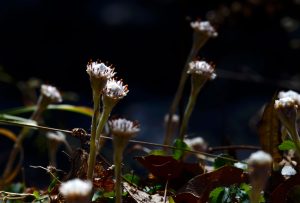

The stream of flowers is mere inches from my face, but I see nothing remarkable as I peer through the camera lens. A bed of brown leaves, beaten down from months of freeze and thaw. A smattering of twigs and protruding rocks. Occasional pockets of moss, a rare shot of color in the bland winter landscape.
Then I ease down the shutter button, and the blooms come into focus. Dozens of five-petaled, purplish-brown flowers appear before my eyes, their bright-yellow centers complementing the below-ground namesake of the yellowroot shrub (Xanthorhiza simplicissima).
I snap the photo, step away, and open my eyes to notice dozens more yellowroot branches popping up around me, with dozens more flowers covering the stems that shoot from bright-green leaves.
Spring tends to work like that, especially in these early stages. The change is invisible, until you notice that first flower, or sprig of new grass. Then, suddenly, you see it all around you.
As I stepped onto the Deep Creek Trail that morning, I saw winter, and I felt winter. Bundled up in a down coat and knit hat against the 36-degree air, I surveyed the brown-tone woods and wondered if I’d see any blooms at all. The cacophony of color exploding across my yard at home—daffodils, tulips, hyacinths—comes from ornamental plants not native to the Smokies. Native species bloom on their own schedule, a timetable borne from millennia of careful adaptation to the often-harsh demands of this mountain environment.

I meandered slowly for that first five minutes or so, walking first to this side of the trail and then to that side, keeping my eyes peeled for any deviation from the browns and greens mottling the forest floor. I was just beginning to wonder if I’d come too early when I spotted it—a single stem rising from the patchwork of fallen leaves, topped with a fuzzy white flower. I’d later learn it was a solitary pussytoe (Antennaria solitaria). And, as would happen a few minutes later with the yellowroot, I’d look up from examining that first specimen to realize it was part of a flock.
The farther I walked, the more signs of spring I saw erupting along the trail—countless rue anemones (Thalictrum thalictroides), their cheery white faces sandwiched between a whorl of purple-green leaves below and tentacle-like yellow stamens above; purple violets, hugging the forest floor closely; and Carolina vetch (Vicia caroliniana), its long, compound leaves and equally long stems of white, pea-like flowers adding a burst of freshness to the view.

But the biggest excitement came about half a mile in, when I looked to my left to see the nodding heads of bloodroot (Sanguinaria canadensis) dotting the steep slope down to Deep Creek, buds about to burst into full bloom. I have a special love for bloodroot, so named for the red rhizome that had an array of traditional uses as dye and medicine. But my admiration for the plant has nothing to do with its namesake. Its spell is instead contained in its ornately lobed leaves, its bright white flowers, and their sunny centers. When I see them blooming, I know winter is over at last.
Though, as in all phases in life, the transition is never a strictly forward motion. The previous week, high temperatures had swelled to just under 80 degrees, but then winter launched a counterattack. As I walked Deep Creek Trail the morning of March 19, the mountains were still recovering from an onslaught of frosty air that had driven temperatures down to the low 20s the previous night.
For me, that meant an urgent return to winter layers. But for hardy native flowers, these violent fluctuations are but a small matter. They know life in the Smokies, and they know how to weather the storm.
For more information about spring blooms in the Smokies, check out Smokies Life’s 2024 wildflower reports or purchase a copy of the pocket field guide Wildflowers of the Smokies.
The Great Smokies Welcome Center is located on U.S. 321 in Townsend, TN, 2 miles from the west entrance to Great Smoky Mountains National Park. Visitors can get information about things to see and do in and around the national park and shop from a wide selection of books, gifts, and other Smokies merchandise. Daily, weekly, and annual parking tags for the national park are also available.